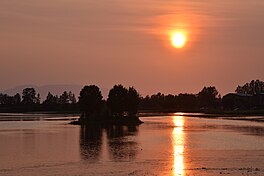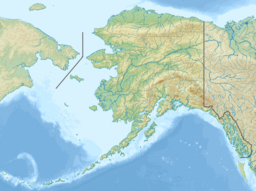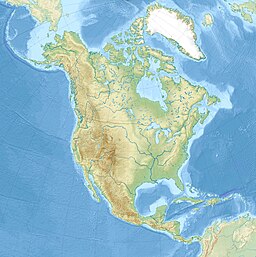
Matanuska-Susitna Borough is a borough located in the U.S. state of Alaska. Its borough seat is Palmer, and the largest community is the census-designated place of Knik-Fairview. As of the 2020 census, the borough's population was 107,801.

Protected areas of South Australia consists of protected areas located within South Australia and its immediate onshore waters and which are managed by South Australian Government agencies. As of March 2018, South Australia contains 359 separate protected areas declared under the National Parks and Wildlife Act 1972, the Crown Land Management Act 2009 and the Wilderness Protection Act 1992 which have a total land area of 211,387.48 km2 (81,617.16 sq mi) or 21.5% of the state's area.

The Susitna River is a 313-mile (504 km) long river in the Southcentral Alaska. It is the 15th largest river in the United States, ranked by average discharge volume at its mouth. The river stretches from the Susitna Glacier to Cook Inlet's Knik Arm.

The Seward Highway is a highway in the U.S. state of Alaska that extends 125 miles (201 km) from Seward to Anchorage. It was completed in 1951 and runs through the scenic Kenai Peninsula, Chugach National Forest, Turnagain Arm, and Kenai Mountains. The Seward Highway is numbered Alaska Route 9 (AK-9) for the first 37 miles (60 km) from Seward to the Sterling Highway and AK-1 for the remaining distance to Anchorage. At the junction with the Sterling Highway, AK-1 turns west towards Sterling and Homer. About eight miles (13 km) of the Seward Highway leading into Anchorage is built to freeway standards. In Anchorage, the Seward Highway terminates at an intersection with 5th Avenue, which AK-1 is routed to, and which then leads to the Glenn Highway freeway.

Spenard is a neighborhood in the Municipality of Anchorage, Alaska, United States and was historically a separate city from Anchorage. Spenard maintains the flavor of a separate community today, with "Spenardi Gras" being its primary community celebration that encourages a sense of solidarity and separation from the rest of Anchorage. Spenard is a central focus of bohemian lifestyle practitioners and artists and writers, and is well known for its numerous poetry jams, bicycle parties, and other similar events.

The George M. Sullivan Arena is a 6,290-seat arena in Anchorage, Alaska, United States. The arena is named after former Anchorage mayor George M. Sullivan. It is owned by the Municipality of Anchorage and operated by O'Malley Ice & Sports, who operates the Ben Boeke Ice Rink. The Sullivan Arena sits in the southwest region of Fairview, a neighborhood in Anchorage. The arena opened in 1983 and sits just east of Mulcahy Stadium as part of the Chester Creek Sports Complex. Sullivan Arena hosted the 1989 World Junior Ice Hockey Championships along with the Harry J. McDonald Memorial Center in Eagle River.

Goose Lake is a small lake in Anchorage in the U.S. state of Alaska, located near the University of Alaska Anchorage, 1.2 miles (1.9 km) south-east of confluence of North and South Forks Chester Creek, and 2.8 miles (4.5 km) south-east of Anchorage, Cook Inlet Low. It is a popular swimming location in summer, with one of two municipal beaches, and is connected to the city's extensive trail system. It is a kettle lake.

The Denaʼina, or formerly Tanaina, are an Alaska Native Athabaskan people. They are the original inhabitants of the south central Alaska region ranging from Seldovia in the south to Chickaloon in the northeast, Talkeetna in the north, Lime Village in the northwest and Pedro Bay in the southwest. The Denaʼina homeland is more than 41,000 sq mi (110,000 km2) in area. They arrived in the south-central Alaska sometime between 1,000 and 1,500 years ago. They were the only Alaskan Athabaskan group to live on the coast. The Denaʼina have a hunter-gatherer culture and a matrilineal system. The Iditarod Trail's antecedents were the native trails of the Denaʼina and Deg Hitʼan Athabaskan Native Alaskans and the Inupiaq Inuit.
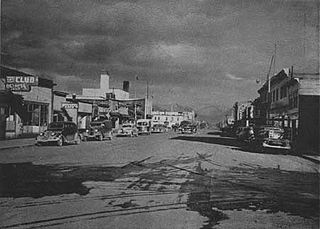
After congress approved the completion of the Alaska Railroad from Seward to Fairbanks in 1914, it was decided that a new town should be built as a port and rail hub along the route. The decision was made to develop a site near Ship Creek on Cook Inlet. Survey parties visited the area in 1914 and researched possible routes for the rails and options for siting the new town. Anchorage was originally settled as a tent city near the mouth of Ship Creek in 1915, and a planned townsite was platted alongside the bluff to the south. Anchorage was mostly a company town for the Alaska Railroad for its first several decades of existence.

Ship Creek (Dena'ina: Dgheyaytnu) is an Alaskan river that flows from the Chugach Mountains into Cook Inlet. The Port of Anchorage at the mouth of Ship Creek gave its name to the city of Anchorage that grew up nearby.

The Municipality of Anchorage is the largest city in the U.S. state of Alaska by population. With a population of 291,247 at the 2020 census, it contains nearly 40 percent of the state's population, and has more people than all of Northern Canada and Greenland combined. The Anchorage metropolitan area, which includes Anchorage and the neighboring Matanuska-Susitna Borough, had a population of 398,328 in 2020, accounting for more than half the state's population. At 1,706 sq mi (4,420 km2) of land area, the city is the fourth-largest by area in the United States and larger than the smallest state, Rhode Island, which has 1,212 sq mi (3,140 km2).
George Murray Sullivan was an American politician who served as the 26th mayor of the City of Anchorage from 1967 to 1975 and the 1st mayor of the Municipality of Anchorage from 1975 to 1981.
Bootleggers Cove is an area of Anchorage, Alaska, just west of Downtown Anchorage and north of the South Addition. Its exact boundaries are controversial. It is served by Inlet View Elementary School, Romig Junior High and West Anchorage High School. Its scenic features include Elderberry Park, the Oscar Anderson House, the Westchester Lagoon, and access to the Tony Knowles Coastal Trail and the Lainie Fleischer Bike Trail. It is located near the tidal flats of Cook Inlet. The Alaska Railroad passes between the residential zones of Bootleggers Cove and the tidal flats. Bootlegger's Cove was affected by the 1964 Alaska earthquake. It is currently represented in the Alaska State Legislature by Representative Les Gara and Senator Johnny Ellis.
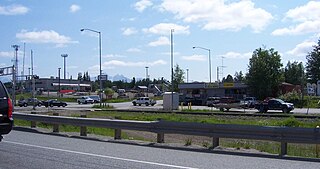
The City of Wasilla (Dena'ina: Benteh) is a city in Matanuska-Susitna Borough, United States and the fourth-largest city in Alaska. It is located on the northern point of Cook Inlet in the Matanuska-Susitna Valley of the southcentral part of the state. The city's population was 9,054 at the 2020 census, up from 7,831 in 2010. Wasilla is the largest city in the borough and a part of the Anchorage metropolitan area, which had an estimated population of 398,328 in 2020.

Daniel Albert Sullivan is an American businessman and politician who served as the mayor of Anchorage from 2009 to 2015 and on the Anchorage Assembly from 1999 to 2008. The son of Anchorage's longest-serving mayor, George M. Sullivan, he was the Republican nominee for lieutenant governor of Alaska in the 2014 election but he and incumbent Governor Sean Parnell were defeated by the ticket of Independent Bill Walker and Democrat Byron Mallott.

Chester Creek is one of several streams that flow through the city of Anchorage, Alaska. It runs for 21 miles (34 km) from the Chugach Mountains to the Knik Arm of Cook Inlet.

Campbell Creek is one of several streams that flow through the city of Anchorage, Alaska. It runs for 21 miles (34 km) from the Chugach Mountains to the Turnagain Arm of Cook Inlet.

Fairview is a neighborhood in Anchorage, Alaska just east of Downtown Anchorage and west of the Merrill Field Airport. The area is a working-class neighborhood of approximately 7,200 residents, with a median household income of approximately $55,000 and a poverty rate of approximately 21%.

Rabbit Creek is one of several streams that flow through the city of Anchorage, Alaska. It runs for 15 miles from the Chugach Mountains to Turnagain Arm. Before English-speaking settlers arrived in Anchorage, the Dena'ina called the creek "Ggeh Betnu."

The trail system of Anchorage, Alaska spans 578 miles (930.2km). The Municipality of Anchorage created the first set of trail systems for recreation in the late 1950s, not developing a system that was commuter friendly until the mid 1960s. The trails, which are used primarily for recreation and commuter traffic, are heavily utilized year round for walking, biking, and skiing. Many of the trail systems in place that connect the city of Anchorage in a commuter-friendly way were kick started by John "Jack" Roderick, the first mayor of the Municipality of Anchorage, who held office from 1972-1975.
